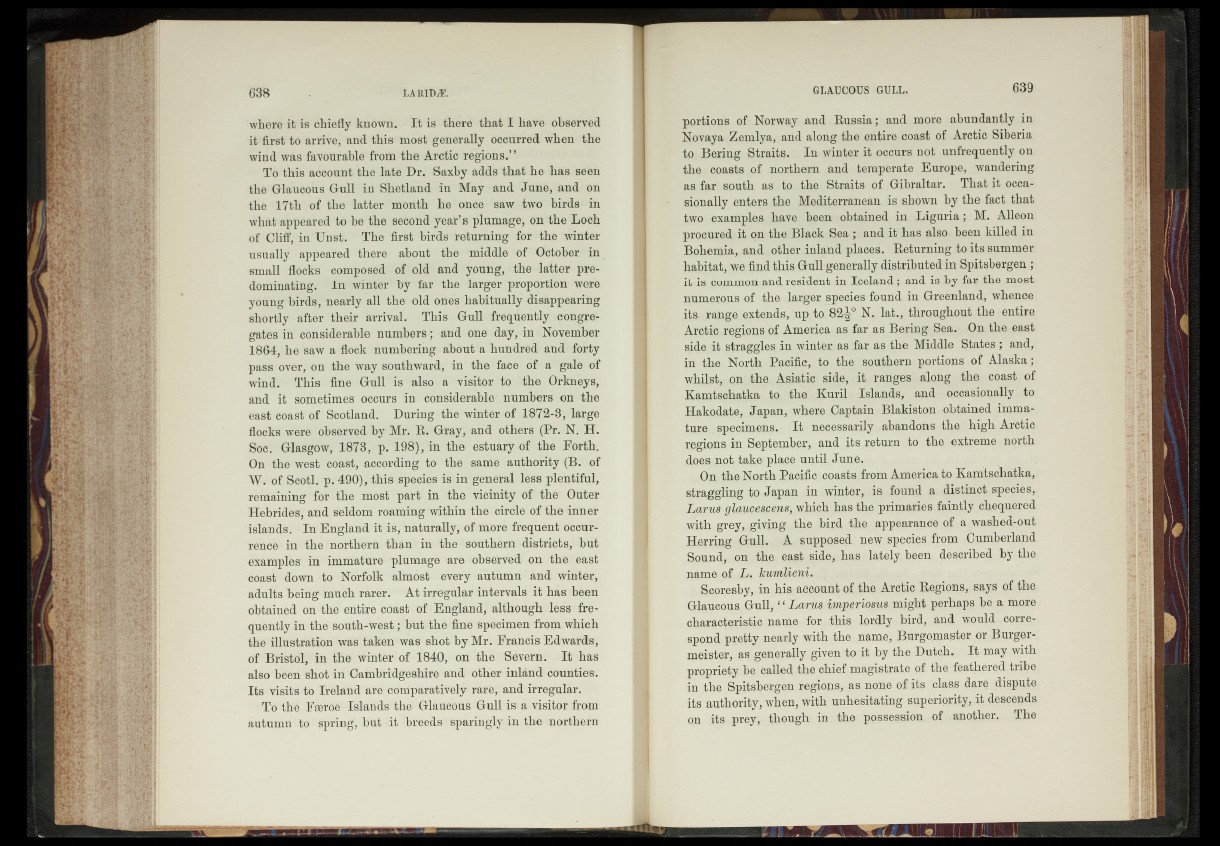
where it is chiefly known. It is there that I have observed
it first to arrived and this most generally occurred when the
wind was favourable from the Arctic regions.55
To this account the late Dr. Saxby adds that he has seen
the Glaucous Gull m’ Shetland in'May and -June, and on
the 17th of the latter month he once saw two birds in
what appeared to be the second year’s plumage, on the Loch
of Cliff, in Unst. The first birds returning for the Winter
usually appeared there about the middle of October in
small flocks composed of old and young, * the latter predominating.
In winter by far the larger proportion were
young birds, nearly all the old ones habitually disappearing
shortly after their arrival. This' Gull*'frequ6Htl$i»congrer
gates i f considerable numbers; and one" day, in-November
1864, he saw a flock numbering about% ^hundred and forty
pass over, on the way southward, in the face of a gale of
wind.’ This fine Gull is'J also a visitor ’to >the Orkneys,
and it sometimes occurs in considerable numbers1 on the
east coast of Scotland. During the'Winter of 1872-3, large,
flocks were observed by Mr. R. Gray, and others (Pr. N. H.
Soc. Glasgow, 1873, p. 198f, in the estuary df1 “the Forth.
On the west coast, according teethe same authority*(®t®of
W. of Scotl. p. 490)/'4his spfeciesis in general less plentiful,
remaining for the most parkin the Vicinity “of the Outer
Hebrides, and seldom roaming withi©>4kr circle; of the inner
islands. In England i¥-|s, naturally, of more frequent occurrence*
in the northern-than im-hhe southern districts,«but
examples in immature plumage are observed* on the east
©oast down to Norfolk almost every' autumn and winter,
adults being^much -rarer. At irregular intervals- it has been
obtained on the-entires coast'-of-England,' although less* frequently
inithe south-west ^butdheifine-Specimen from.which
the illustration was taken was shot by Mr.« Francis Edwards,
off Bristol, in the winter-of 1840, on the Severn. Itvhas
also been shot in Cambridgeshire and other inland counties.
Its visits to Ireland ar^Comparatively rate, and irregular.
To fhe PeeVee* Islands-the Glaucbufe GulUi^a-visitor from
autumn to u r in g ; but -it ibreels ''sp&rihgi§din the- northern
portions of Norway, and Russia; and mere abundantly in
Novaya Zemlya, and along the entire coast of Arctic Siberia
tp- Bering Straits. In winter it .occurs not unfrequently on
the coasts of northern and temperate Europe, wandering
as far south, ask to the Straits of Gibraltar. That it occasionally
enters the Mediterranean is shown by the fact that
two examples ..have been obtained in Liguria; Mi. Alleen
procured it on the Black Sea ; and it has. also been killed in
Bohemia,, and other inland places. Returning to its summer
habitat, we find this Gull generally distributed in Spitsbergen ;
it is common and resident in Iceland; and isjby far the most
numerous of the „-larger species found in Greenland, whence f
it;s. range.extends, up-to 82^°, N* latf, throughout the entire
Arptic regions of America as far as Bering Sea. On the east
side, ’it straggles; in w in te rs far as the Middle States ; .and,
in the North Pacific, to the southern portions of AlaskaJj
whilst,on .fhe Asiatic? side, * it .ranges along .the coast of
Kamtschatka to. the; Kuril Islands, and occasionally .to,
Hakodate, Japan, where jQaptain Rlakiston obtained immature
^specimens. It-, necessarily abandons ithe high Arctic
regions in Septembers and ;i*ts -return ,tov the extreme -north
does not take place until Juno.,,
On the North-Pacific,coasts;from Americano Kamtschatka,
straggling to Japan in winter,,;is found a distinctSpegies,
L'aruß glaucßsgevns] which has the primaries faintly chequered
with grey,.gjving the bird the appearance of a washed-out
Herring A «.supposed; new^specips from fiumberfand
Sound., on' the- east gjdegrhp lately been, described by the
name of ,L.
his account of, the Arctic Regions,.- says of the
Qlaucous .Grull,;“ Larusdynperios^s might perhaps be & more
characteristic name for; this- lprdly bird, and would ,correspond
pretty nearly with-the name,, Buigonpster or Burger-;
meister, as], generally, given ftoJit by the Dutch.» It may .wi%>
propriety be Calledthg chief magistrate,!£$ thejfeatherfd.tribe;
in the Spitsbergen^regions, as none ©fits class darp. dispute,
its authority, when, with unhesitating superiorly it descends -
qn its .prey; though- in the poSsoggioju of anofheij-j The